So, after the visit to Vietnam, we moved on to Cambodia where we were to visit Angkor Wat. The temple is famed all over the world as one of the most beautiful temples. The plans were to see the renowned sunrise over Angkor Wat, explore the grounds and see some of the other temples in the area.
The first morning at Siem Reap was a bit of a wash (both literally and figuratively) as the rain came down heavily and put paid to our plans of viewing the sunrise at Angkor Wat. I didn’t have to get out of bed since my ever-vigilant father woke up and noticed the rain. We still got up nice and early at about 7 am by which time the rain had stopped. We visited Angkor Wat to explore the grounds and the interiors of this temple campus while the sun was still low, and the morning was cool. Ka Pauv took us to the temple grounds on his tuk-tuk and introduced as to our tour guide.
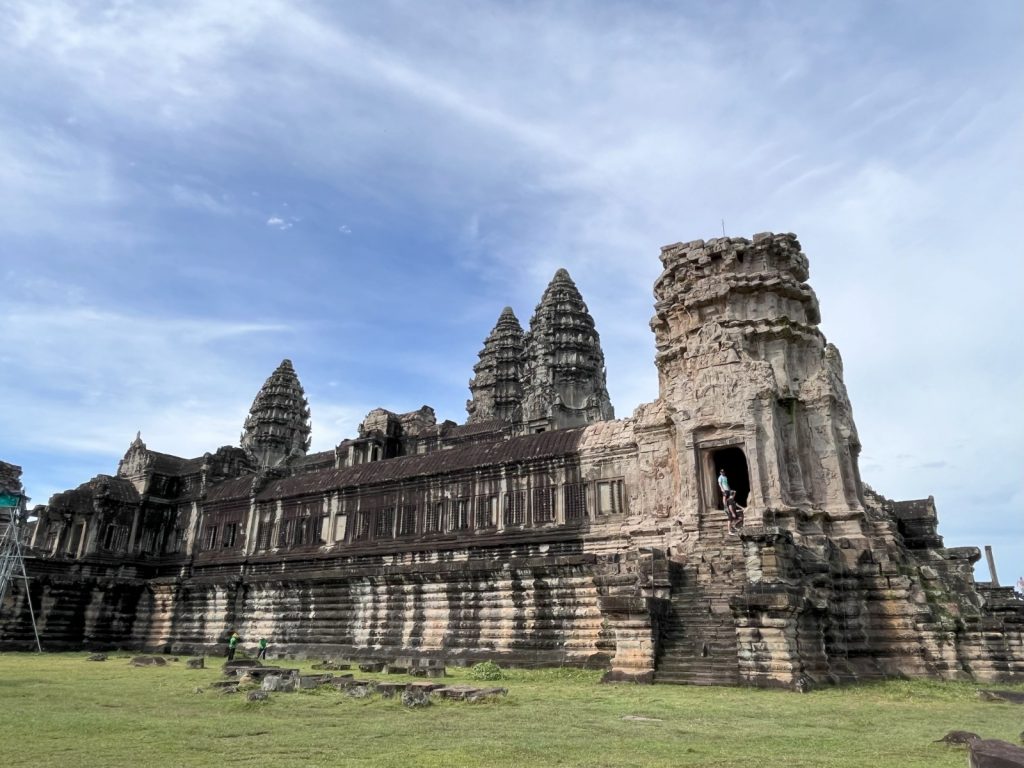
The Angkor Wat temple is at the centre of a huge area spanning 162 square-kms. This includes a gigantic, completely hand-dug moat, acres of empty fields and the occasional temple structures. Ensconced in these layers of defence lies the main temple an elaborate multi towered structure with walls adorned by carvings of gods, heavenly apsaras and other creatures. The quickest path there from outside where we had parked is a straight pathway complete with ‘naga’ balustrades. This is a causeway connecting the western ‘gopura’ or entrance gate to the main structure over the moat. The guide showed us that the pathway had a foundational level made of different stone material that had been brought from some far away mountains.
The pathway eventually reaches the temple outer ramparts (between the moat and the main compound). This structure holds a statue that some people were worshipping when we passed. I t was the statue of the eight-armed Vishnu or Ta Reach who people pray to for prosperity. Through the gate we arrived in the main compound of Angkor Wat. At some point this space had probably been bustling with life but years of abandonment and jungle overgrowth had most probably reclaimed most of the wooden structures.
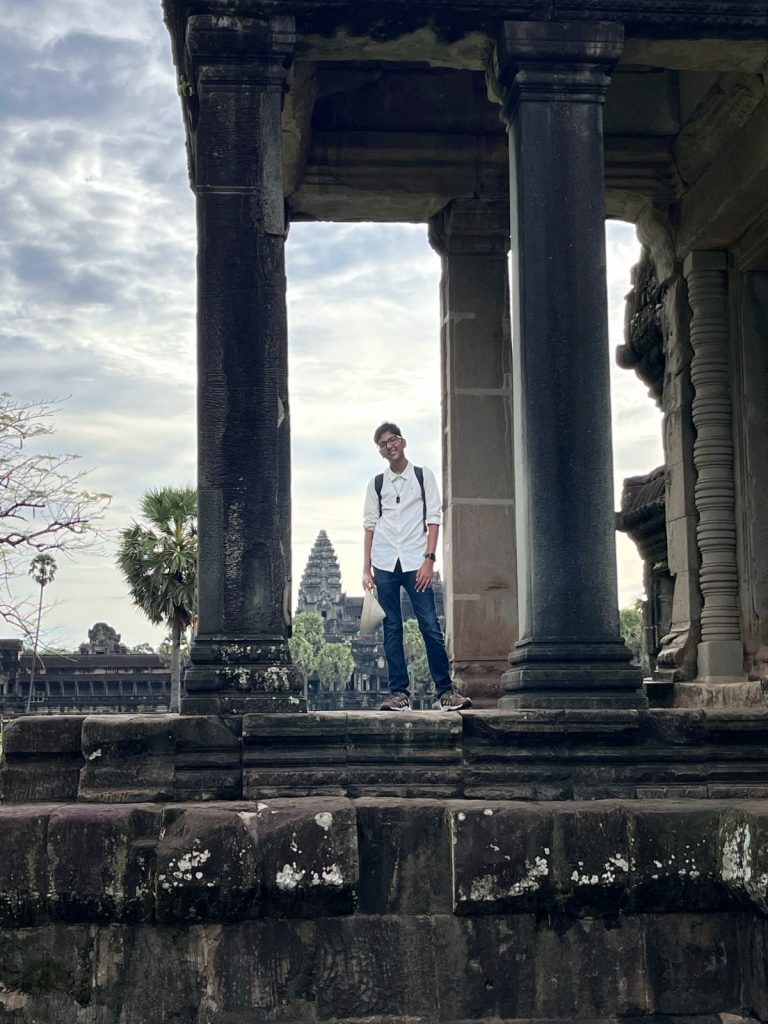
This means that a large part of what is protected by the wall is just an empty field but there are a few small buildings of note, namely the libraries. Whatever was stored there is long gone but the buildings offer a brilliant view of Angkor Wat. We didn’t spend too long there though, as the guide led us off the causeway to the left we passed a row of shops. A lot of the shops were selling paintings or models and my mother bought an elephant for her collection. Since we had missed the sunrise opportunity, we decided to find the best spots to view Angkor Wat in the morning sunrise to position ourselves the next day. A big part of these viewings is to catch the reflection of the Wat and the sun in water but the water on this side of the temple was both murky and fenced off so we realized this would not be the right place to watch the sunrise.
After that we made our way into the main temple of Angkor Wat a huge structure with 5 towers and a large gallery surrounding it. The walls of the galleries were decorated with beautiful imagery which I realized were of four or five main types, one representing the Battle of Lanka with a many-headed Raavan, Hanuman carrying Mount Dronagiri another one representing the Battle of Kurukshetra featuring Karna fighting with his chariot wheel stuck in the mud, Bhishma on his bed of arrows and more; the third types showed the Khmer army’s might in a great military procession featuring the king at that time, his general and detailed images of all the corps they commanded. The coolest gallery painting in my view were the last ones featuring Heaven, Earth and Hell, showing the devas in heaven, sinners being subjected to punishments in hell and the god Yama deciding people’s fates. Finally, one gallery wall showed the incredibly popular churning of the ocean imagery used in the temple sculptures and paintings. The galleries were all done in the same style and while they weren’t in the best condition a lot of the painted figures were recognizable.
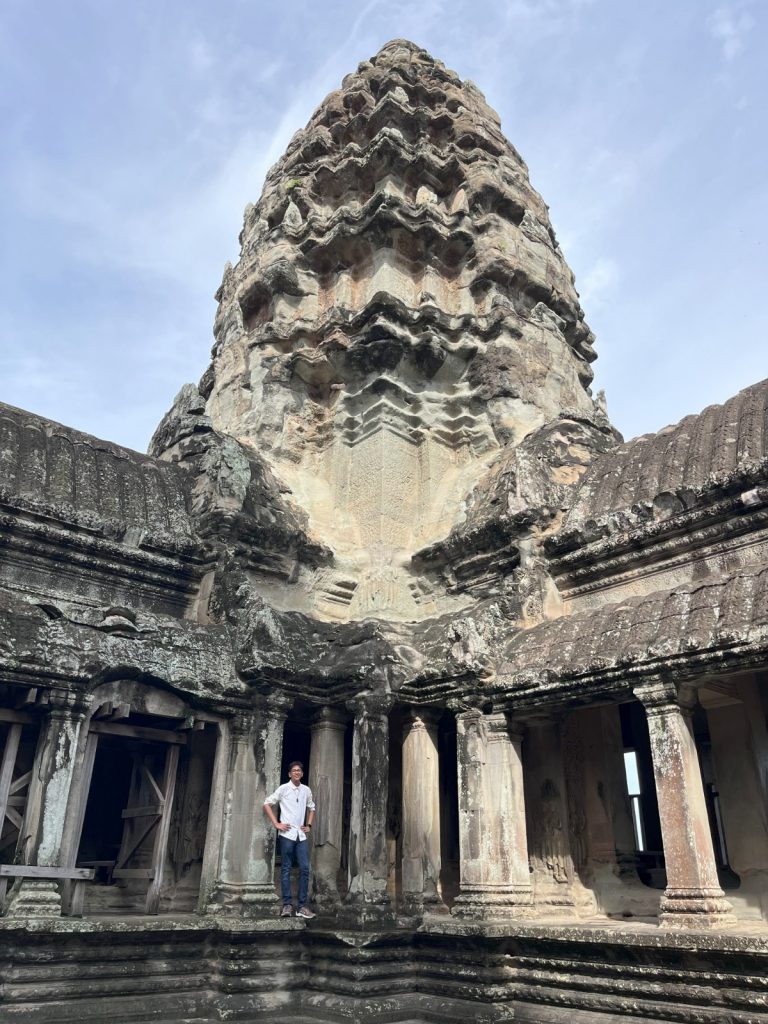
Past the outer galleries you enter the interior of the temple where there was a lawn and a tower rising up from the centre. The central tower represents Mount Meru, which is considered very holy in Hindu mythology, and at the very top level of it is the resting place of the remains the builder of Angkor wat, King Suryavarman II. The central tower visit involved a steep stair climb and our guide was not going to be joining us. We left our stuff with him and began the slightly scary ascent. Thankfully it was not as steep as it had seemed from the bottom and there were handles all the whole way up that we used to balance ourselves. The top had a similar shape as the compound as a whole did, with a central area, a path around the very outside and small hallways leading inwards in two directions.
We explored the place and offered our respects to the great King Suryavarman II for whom there was a shrine in one of the two hallways. At one point a young monk stopped us and asked for a picture with me which was a pleasant surprise as a large point of discussion in Facebook Groups is how to be respectful about clicking pictures with monks.
After spending a while up top, we began the descent. My parents were lightning-fast speeding their way to the bottom of the tower but I was a little more cautious and took it slower much to their amusement. We found the guide again who led us out of the main structure of Angkor Wat and back down the causeway. Here we stopped at the libraries and though it was an empty stone structure it offered a brilliant view of Angkor Wat. Also, this time we checked out the waterbodies on the other side of Angkor wat approach and found a spot which we would use to view the sunrise the next morning.
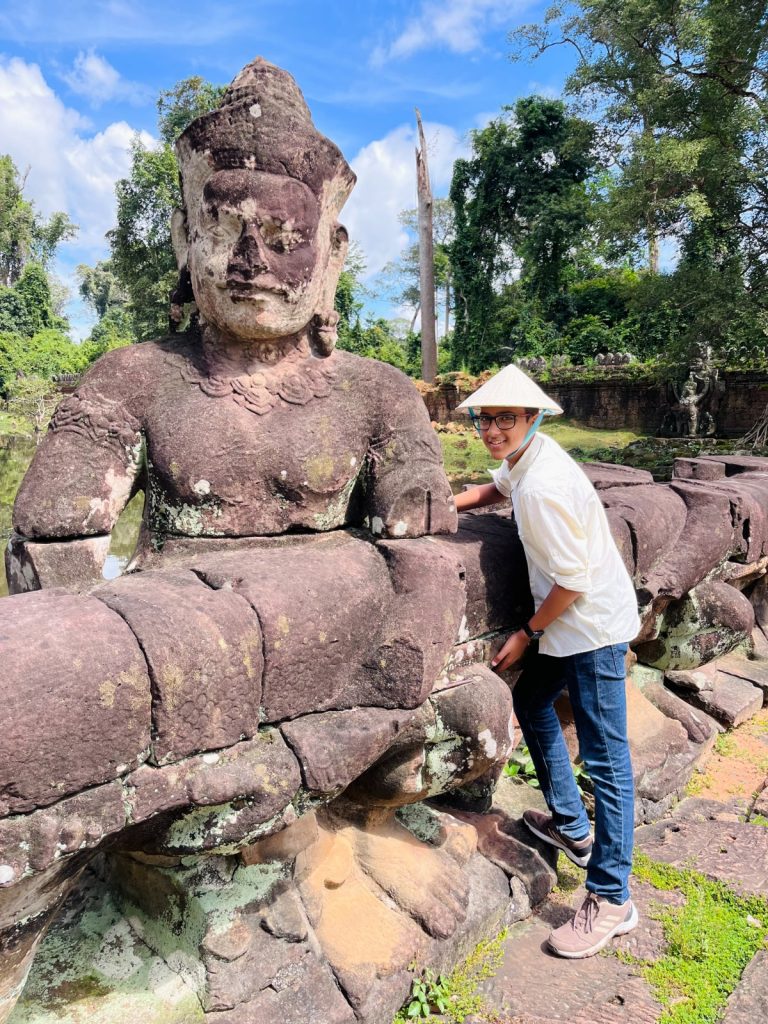
By this time, we were getting a little hungry so after reaching the parking lot again we looked for restaurants with breakfast options. Ka P. told us that there is a restaurant by Preah Khan where we would be headed next. There a slight mix-up with the guide about other temples where he would take us such as Ta Prohm which we originally did not plan on visiting though it was one of the most famous. Anyways after clearing that up, we reached the restaurant across the street from Preah Kahn. We head a hearty breakfast before continuing into Preah Khan.
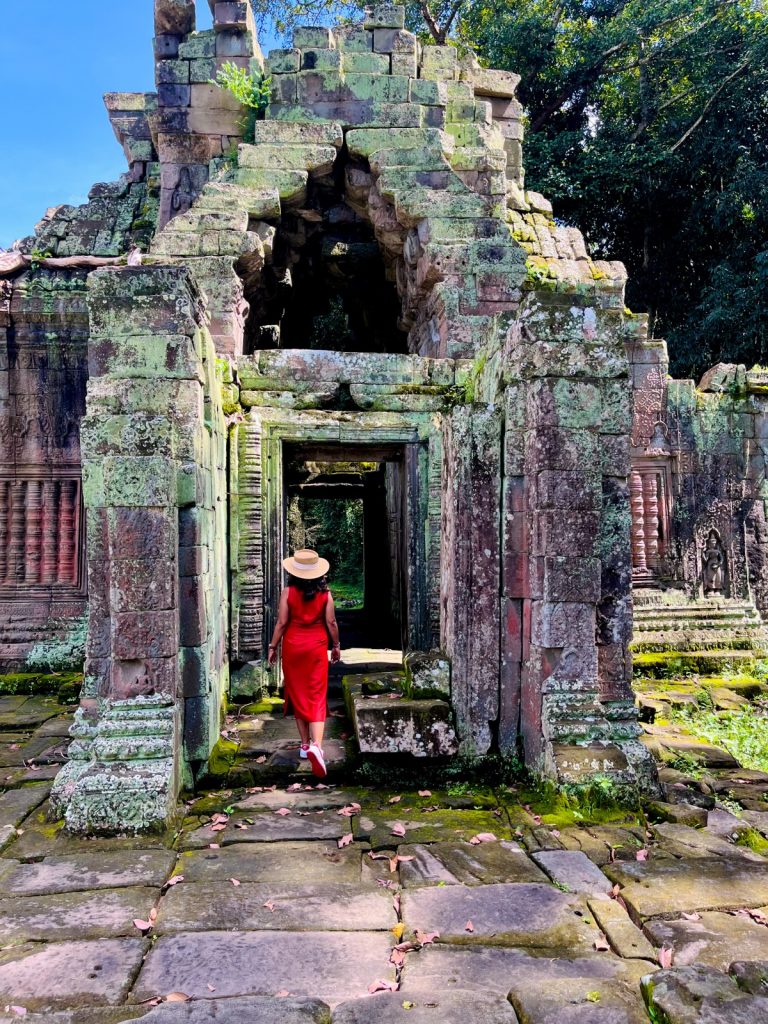
Preah Khan means holy sword as this temple was built to commemorate King Jayavarman VII’s victory over invaders. The site is much smaller than Angkor Wat as the main temple is just a short-shaded stroll from the gate across a far smaller moat. The walls of the temple are decorated with Garuda holding nagas. This temple includes a dharmshala in the centre but the interior pathways which were anyways a little cramped have also slowly collapsed and blocked up making navigation difficult. On the floor there were the bases of some Shiv Lings which we learnt had the main statue parts stolen. The central sanctorum imagery is a depiction of someone on the path to awakening in the form of the King’s Father. When we reached the central courtyard, we saw a pool of water covered in green and with the sun beating down and the heat roasting us we all had half a mind to go for a swim in it. Some of the outer walls of Preah Khan had huge trees with white bark growing out of them which looked really cool.
We probably would have enjoyed that temple a lot more if the sun had been lower in the sky,we left pleased and incredibly happy to be in the shaded walkway. On the way to our next stop, we passed a gateway overarching the road with four faces like the Bayon temple’s towers which we would be visiting later that day. After stopping and clicking some picture we drove on to Ta Prohm.
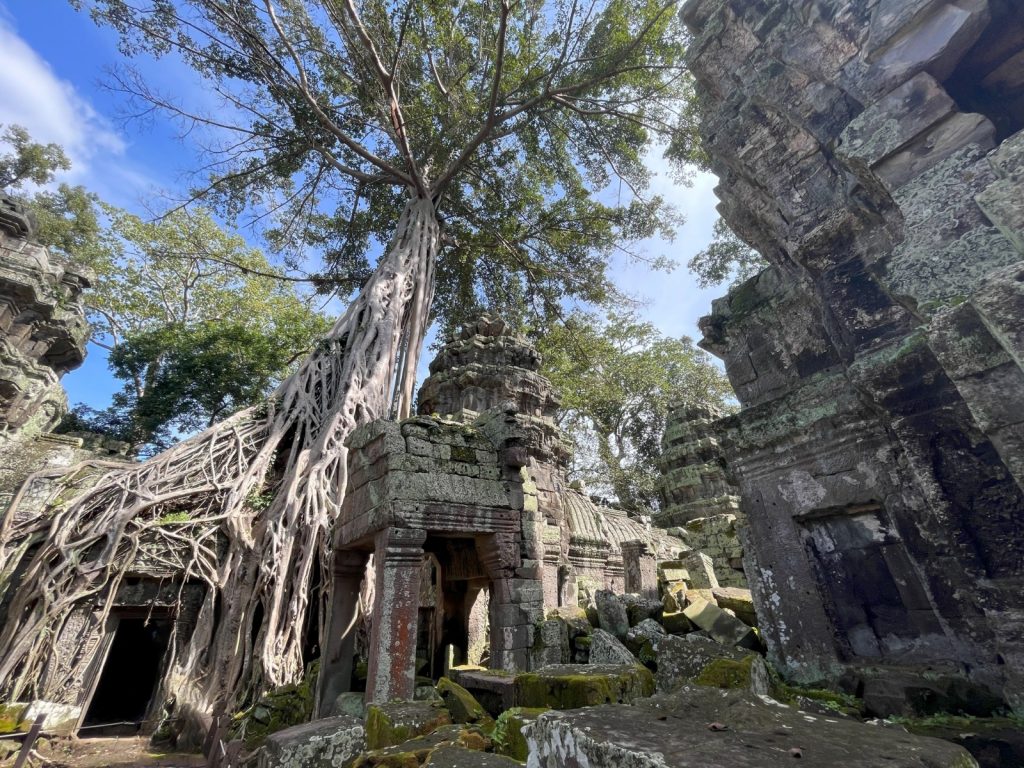
The next temple we were going to visit Ta Prohm, is one of the most famous as it was used as a filming location for the movie – Lara Croft: Tomb Raider and the spot in Ta Prohm which featured in the Angelina Jolie-starrer has a queue out front. According to some research this temple is a smaller more ruinous version of Preah Khan and so it was not on our original temples to visit list. Still the temple was nice though a little crowded. The trees growing out of this temple were even cooler than some of the ones at Preah Khan, the trees are one of the main attractions. The other main attraction of Ta Prohm is the dinosaur of Ta Prohm, a supposed stegosaurus depicted as a wall sculpture, that could be anything from groundbreaking historical evidence to a model from a film-maker. Ta Prohm had not been renovated as much as some of the others and we joked that that was due to the fact it was being repaired in collaboration with our government.
That was the last temple we visited before a taking a break till the evening where we (minus the guide) would be back to visit Bayon.
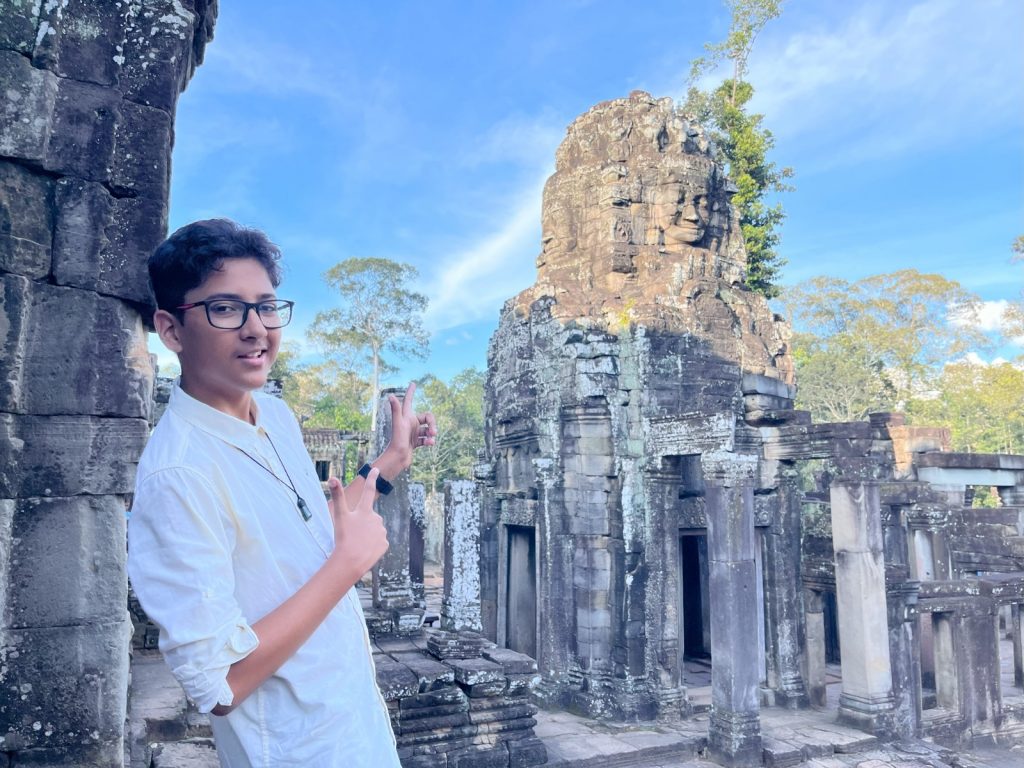
After a few hours of chilling at the hotel, we piled back into Ka Pouv’s Tuk-Tuk to visit my favourite temple of this whole trip, Bayon. The drive was smooth and cool as the sun had all but set when we reached Bayon. Bayon is situated on top of a hill overlooking the Elephant Terrace (exactly what it says on the tin). Bayon was the last state temple built by the Khmer kings and features around 200 massive faces. One thing I did notice was that the temple seemed too big for the hilltop it was allotted most likely from the sheer number of individual towers. The faces on the towers are most likely those of King Jayavarman VII who built it but are said to represent either Buddha or Bramha. When we first entered the complex, we chose to follow the signs and the path but that took us nowhere and very soon we were lost and losing light. The light of the setting sun illuminated the central tower and made it look almost golden creating an epic effect.
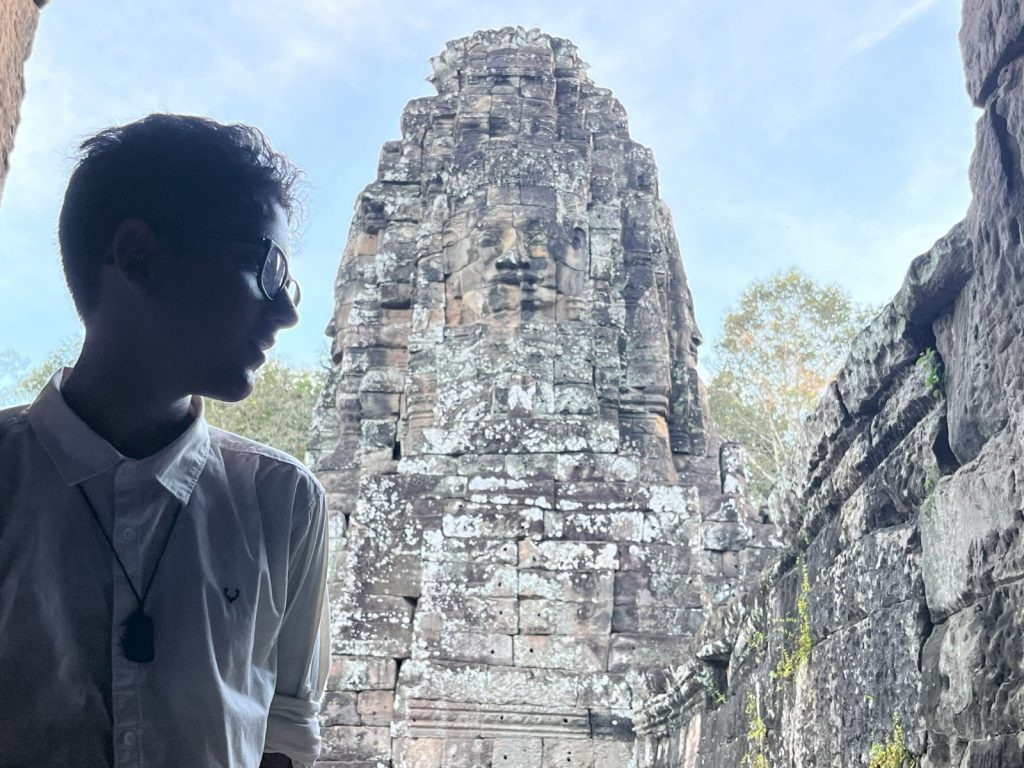
We had hoped to get to the terrace for a picture where it looks like one is talking to the face, but the top-level terrace was closed for renovations and we spent a lot of time walking around in circles trying to find an entrance. So much in fact that my parents decided to give it up and sit down. I, on the other hand, did not give up so easily and persisted trying to find any spot kind of level with a tower. I found a very thin ledge that led to a passageway that opened to some stairs leading down. The point was not perfect but was at a good level and with some effort we made the picture work. After that the sun started to get quite low and we left Bayon. That evening we went to a fine dining restaurant for a sumptuous Cambodian dinner, the cuisine seemed to have a lot of similarities with Thai such as a Mango and Sticky Rice. Though since this was such a fancy restaurants there were jackfruits and coconut shavings! Madness! Either way during the meal I realized all these countries – Thailand, Cambodia, Vietnam, Myanmar etc had common cultural and social origins.
We slept in the cool hotel room hoping that the next morning would be dry and we would get to see the sunrise.
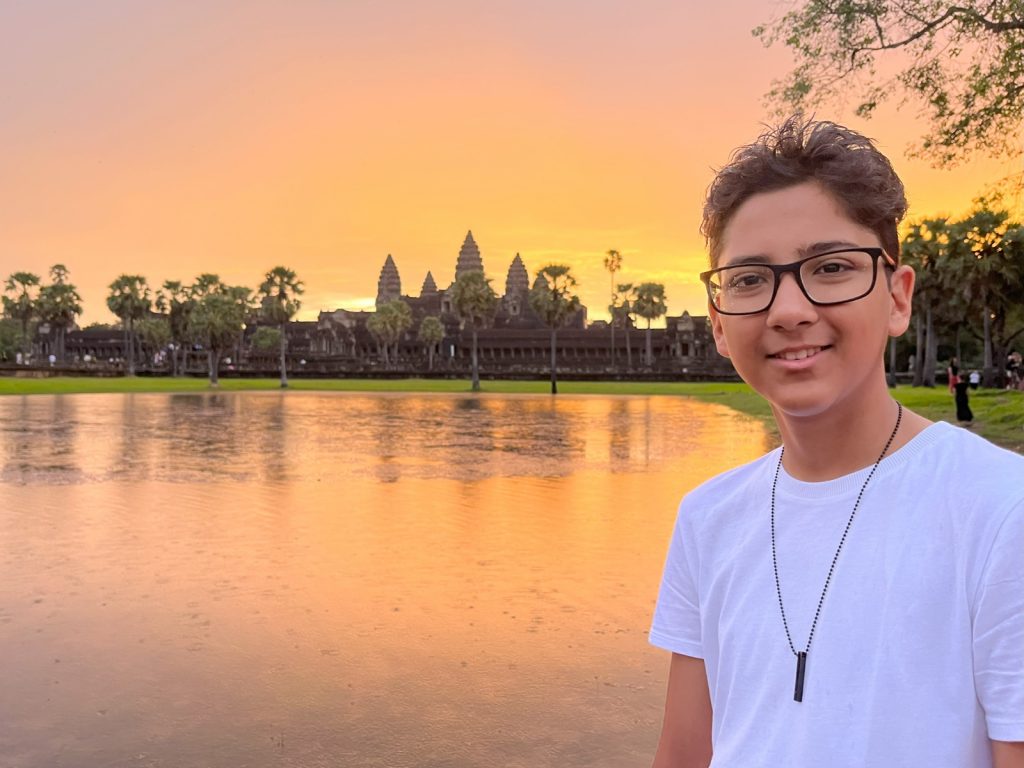
The morning was dry but there were still some indications of rain in the air and that had a slight effect on the view. We left quite early but there were already people when we arrived at the temple site. Thankfully we had planned and knew exactly where we could catch the view from and it was amazing. We even met someone taking a timelapse picture of the whole sunrise from that spot. Normally I would take the time to describe the events but here you truly need to see it to believe it.
After the sun had risen, we explored the outside of the main Angkor Wat temple checking out the relief on the pillars and outer walls and experimenting with some photo clicking techniques. It was nice and relaxing to stroll through the place and explore at leisurely pace..
We returned to the hotel for brunch and after packing our stuff by midday we checked out of the hotel to explore more temples before heading to the airport for our flight to Bangkok. For this last part we would be travelling by a van and not the tuk-tuk. By this time the sky had cleared of all cloud cover and the sun was boiling and we couldn’t appreciate the truly beautiful reliefs and imageries that the temple at Banteay Srei had to offer. This included doorways with the Ram, Sugriva and Vali fight and the Natraj as well as Hanumans and images from the Mahabharata in other places. A little distance from the temple we found a seating and viewing area overlooking some rice paddy fields. While the view was not new to us it offered a cool shade which we desperately needed.
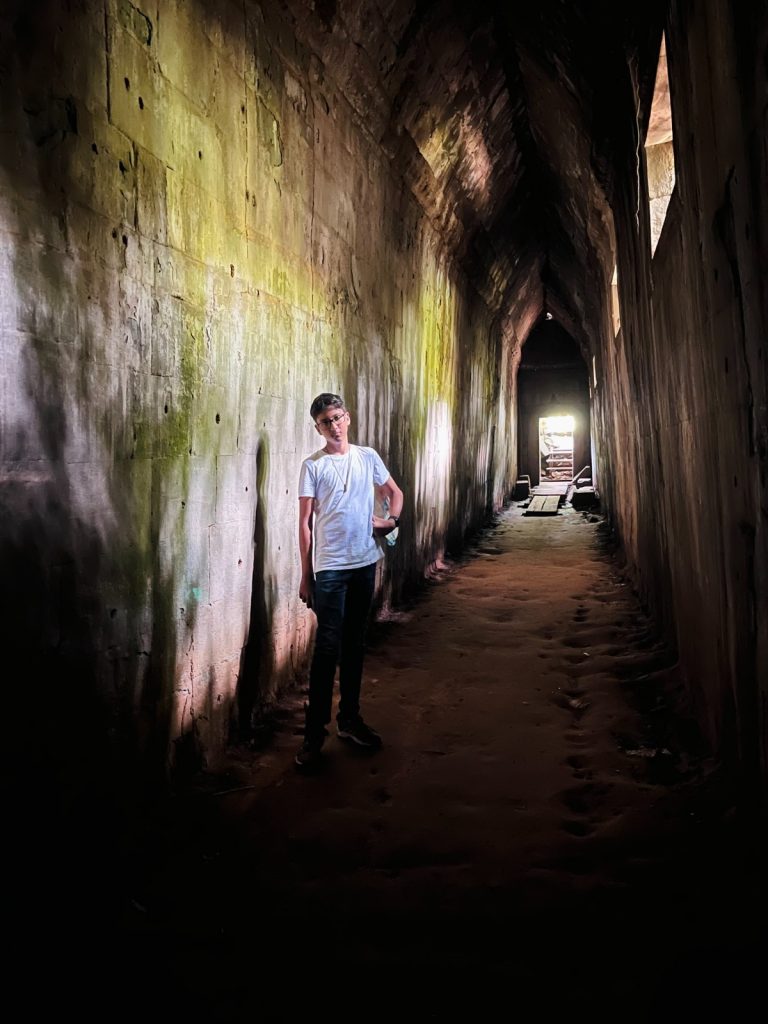
After Bantay Srei, we decided to stop of at another temple. Beng Mealea. We had not heard of this temple but Ka Pouv, our guide, promised us it would be good. The temple was very different from everything else we had explored thus far due to the fact it was still completely in ruins though it was a World Heritage Site. The ruined state of the temple made it way more fun to explore than anything else. The only evidence of a modern presence was the signs pointing us in the right direction. The ex-temple featured some dark corners, wild-growing trees and a broken roof acting as a floor. At one point we found a dark shadowy corridor populated by bats. The corridor was probably more connected before as now it just led to the outside world of moss stones.
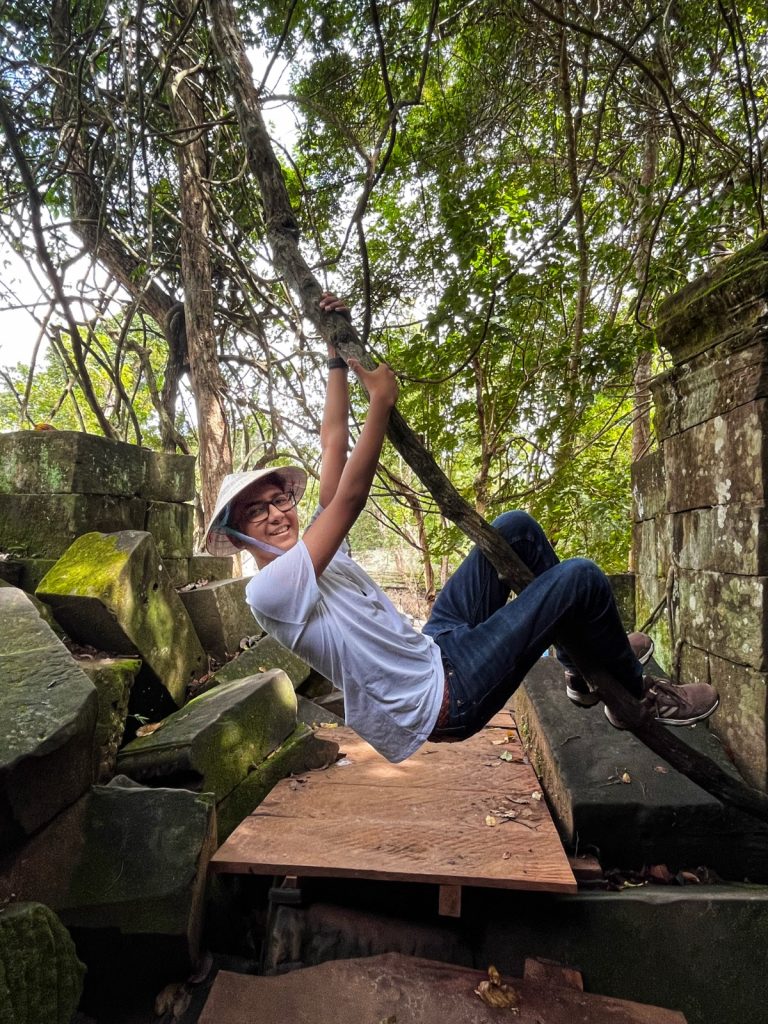
The piles of rubble reached awe-inspiring heights sometimes in stacks so high they must have toppled long ago. One of the coolest things was the number of trees and plants and my parents pulled of some stellar Koala impression hanging of the branches. Though my mother was quite unsteady on her tree. The entirety of the temple was really entertaining to explore if a bit tiring from the hundreds of rocks to climb. So before leaving we took some rest on a hammock-like and then exited the stunning ruins and left for the airport. That was our time in Cambodia where we fulfilled my mother’s lifelong dream of visiting Angkor Wat.
Warmly Welcome all dearest value friends &visitors to my Beautiful Siem Reap Angkor wat Cambodia, a famous gate way to the Angkor Wat, Cambodia Kingdom of Wonder.
My Name is #dolSavoeurn experienced local an English speaking Tuk Tuk & car Driver.
I provide all types of private transports and activities located in Siem Reap Province Cambodia.
I’m always ready , excited and blessed to servers all of you guys needed without exception.
If you guys are looking for a reliable, honesty, experienced and knowledgeable, private an English speaking driver Transportation, please kindly contact me via WhatsApp/ Telegram+85598872338
my website:www.angkorprivatedriver.com
tripadvisor below 👇
https://www.tripadvisor.com/Attraction_Review-g297390-d4555352-Reviews-Mr_Savoeurn_Angkor_Wat_Driver-Siem_Reap_Siem_Reap_Province.html
see you soon!
My name is Veng.I’m a English speaking Driver.
Whatsapp:+855963333765